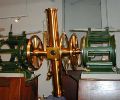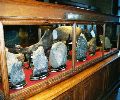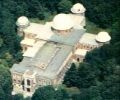Guided tour through the Kuffner Observatory
by Günther Wuchterl
Verein Kuffner Sternwarte, Vienna, Austria
 The Kuffner Observatory, founded in 1884, hosts the MACE 2006 meeting. The dome of the main
building houses a double refractor for visual and photographic use, with apertures of 27 cm
and 15.6 cm, respectively. Working on this instrument, Karl Schwarzschild discovered the reciprocity
failure of photographic emulsions. The second dome houses a Heliometer, a special instrument
for measuring stellar parallaxes by visual observation. With an aperture of 21.7cm and a
focal length of 3 meters, this is the largest instrument of it's kind. Furthermore, the
observatory houses a meridian and a vertical circle.
The Kuffner Observatory, founded in 1884, hosts the MACE 2006 meeting. The dome of the main
building houses a double refractor for visual and photographic use, with apertures of 27 cm
and 15.6 cm, respectively. Working on this instrument, Karl Schwarzschild discovered the reciprocity
failure of photographic emulsions. The second dome houses a Heliometer, a special instrument
for measuring stellar parallaxes by visual observation. With an aperture of 21.7cm and a
focal length of 3 meters, this is the largest instrument of it's kind. Furthermore, the
observatory houses a meridian and a vertical circle.
Weather permitting, observations with the historic instruments are planned.
Guided tour through the Meteorite Collection of the Natural History Museum
by Christoph Goldmann
Verein Kuffner Sternwarte, Vienna, Austria

The Natural History Museum in Vienna boasts the largest display of meteorites in the world.
Not only is the Viennese collection large, it also has the longest history of all meteorite
collections. Meteorites were already collected in Vienna when they were otherwise still
regarded as fairy stories, or as earthly phenomena at best. The museum remains an important
research centre in meteoritical sciences until today.
The display includes various classes of meteorites, incluing specimens that originated on
the asteroid (4) Vesta, others come from Mars, and some are possibly of cometary origin.
[ No navigation? Click here ]
 Inaugurated by Emperor Franz Josef I in 1883, the University Observatory still hosts
the most important astronomical research and teaching institution of Austria. It
combines - in a unique fashion - the beauty and representative architecture of
the late 19th century with modern international research. A visit to the observatory
will provide a historical overview of both science and architecture, a presentation
of treasures from our rare book collection starting from the 15th century, including
authors like Peuerbach, Copernicus, Kepler, Hevelius, Cellarius, Newton, and many others,
and a chance to observe with the large 68cm-refractor, weather allowing.
Inaugurated by Emperor Franz Josef I in 1883, the University Observatory still hosts
the most important astronomical research and teaching institution of Austria. It
combines - in a unique fashion - the beauty and representative architecture of
the late 19th century with modern international research. A visit to the observatory
will provide a historical overview of both science and architecture, a presentation
of treasures from our rare book collection starting from the 15th century, including
authors like Peuerbach, Copernicus, Kepler, Hevelius, Cellarius, Newton, and many others,
and a chance to observe with the large 68cm-refractor, weather allowing.
 The Kuffner Observatory, founded in 1884, hosts the MACE 2006 meeting. The dome of the main
building houses a double refractor for visual and photographic use, with apertures of 27 cm
and 15.6 cm, respectively. Working on this instrument, Karl Schwarzschild discovered the reciprocity
failure of photographic emulsions. The second dome houses a Heliometer, a special instrument
for measuring stellar parallaxes by visual observation. With an aperture of 21.7cm and a
focal length of 3 meters, this is the largest instrument of it's kind. Furthermore, the
observatory houses a meridian and a vertical circle.
The Kuffner Observatory, founded in 1884, hosts the MACE 2006 meeting. The dome of the main
building houses a double refractor for visual and photographic use, with apertures of 27 cm
and 15.6 cm, respectively. Working on this instrument, Karl Schwarzschild discovered the reciprocity
failure of photographic emulsions. The second dome houses a Heliometer, a special instrument
for measuring stellar parallaxes by visual observation. With an aperture of 21.7cm and a
focal length of 3 meters, this is the largest instrument of it's kind. Furthermore, the
observatory houses a meridian and a vertical circle.
